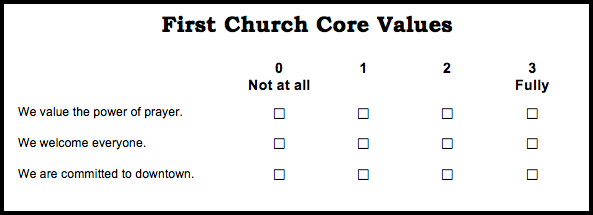Over the years, there has been a good bit of conversation amongst church leaders, consultants, and coaches about congregational values – as in, every church needs to identify their core values. All that’s fine and good, but far too often I’ve come upon churches that spout their values as if they’re water springing from a bubbling fountain, but once they hit the ground they just sort of turn to mud. In other words, they really aren’t worth the paper they’re printed on in terms of how the church approaches its ministries. That being so, this post has been written to (1) take the mystery out of values, (2) help congregations discern and develop their core values, and (3) ensure that their values make a difference in what and how the church operates.
First, what’s a value? Simply put, a church’s values are the answer to “What’s really important to your church?” You can easily discern a church’s values by taking a look at their calendar and their checkbook (budget). Where a church puts its money and its energy reflects what’s really important to it. So if a church puts a lot of money and energy into constructing new offices and classrooms, guess what’s important. On the other hand, if it puts a lot of money and energy into events designed to attract unchurched people into the presence of the church members, guess what’s important to them. The sad fact is, if you look at most churches’ calendars, checkbooks, and board minutes, you’ll discover that their two core values are “Personal Comfort” and “Status Quo.” In other words, “It’s MY church, so don’t change NOTHIN’.”
Most churches' two core values are "Personal Comfort" and "Status Quo. @billtb Share on XNext, it’s important to understand the difference between idealized values and realized values. An idealized value is something we “think” should be important. For instance, I’ve yet to work with a church who didn’t try and tell me, “Well, evangelism is important to us.” My first question to them tends to be, “Really? How many adults did you baptize last year?” The silence almost always says it all. Yes, evangelism may be “important,” but if a church isn’t practicing it with their hearts and souls, then it’s really not a value. On the flip side, a realized value is one that is apparent and almost always easily discernable in the church. I was recently at a church that claimed to value children. I thought that this might be an idealized value, until I discovered they had three outdoor play areas for children, on onsite preschool, and a well-run children’s music program. This was a realized value for that church. (A realized value doesn’t mean more can’t be done, but the value itself is manifest.)
Really, evangelism is important to you? So how many adults did you baptize last year? @billtb Share on XHaving said all that, I’ve unfortunately found few helpful tools for discerning and developing congregational core values. So here is a process I’ve used in the past that seems to be helpful.
- First, it’s good to begin with a Bible study about what Jesus valued. In my personal theology, I point to Jesus’ invitation to “Follow me” to mean more than just getting ourselves out of the boat and onto his path. I take it to mean, “Do what I’ve taught and value what I value.” Seeing what Jesus really valued as shown by both his words and even more so by his actions, is important. For instance, although Jesus was always compassionate with the poor, relieving the systemic causes of poverty wasn’t one of his core values (not once do we see him specifically addressing poverty – with the exception that he mentioned it wasn’t ever going to go away). That’s not to say we should not offer a compassionate alternative, but it at least gives us an idea of what Jesus thought was central to his ministry. On the other hand, as an example, clearly Jesus did value prayer: we see him practicing that over and over and over again.
- Second, it’s important to note that a church’s values are core to the what and the how of the church’s ministries. Since all behavior reflects a core value, then a church should have only a few – certainly no more than five – core values. An example of how values are effectively manifested in a church can be seen in the example of valuing prayer. If a church values prayer, then nothing is done in public or private, in classes or in meetings, without significant prayer. We’re not talking about parentheses prayers (open and closing prayers that are little more than nods to the Divine), but real, heartfelt prayer. Every council meeting agenda would have time set aside for prayer, especially before any major decision making was made. There would likely be a cadre of prayer warriors, gathered in a room separate from the council, who would be keeping the council members in prayer during the meeting. That same group, or another, would opt out of worship services on a rotating basis so they could spend the time praying for worship leaders, the pastor, and the participants. A value is more than a word or phrase – it drives the church’s behavior.
- With the basics covered, it’s time to discern the current realized values of the church. As a church leader you probably already have a hunch about some of them. To verify your hunches, check the church’s calendar for the past 12 months and look at the events the church has engaged in. Any value you’ve discerned should find corresponding events. For instance, if “Family” is a value, then you should be able to find events that support and cater to the needs of families. If prayer is a value, you’ll see events like those I’ve described in the second step above.
- Once you’ve done that, check the values against the church checkbook. How the congregation spends money is a key indicator on what it values. For instance, if the church says it values reaching the community through its food bank, we’d expect to see the food bank in the church’s budget (and we’d also expect to see significant participation by the wider congregation, not just a handful of volunteers).
- At this point, the list of realized values is probably either very short or very shallow (as I’ve said, the two core values of most churches is “Personal Comfort” and “Status Quo”). The next step is to discern what idealized values the church honestly would like to (or would be able to) realize. The key here is to remember the following formula: “Beliefs drive Values. Values drive Behavior.” Values must reflect what the congregation actually believes and the values must also reflect what a congregation will actually do. Thus, most mainline churches aren’t really equipped or able to realize evangelism as a value – it might be a nice ideal, but to focus a church’s behavior around evangelism is generally too much to ask as a reality.
- When you’re done with your work, bounce it off of your exec team. If it flies, take it to your board/session/council/vestry. If they give it a thumbs up, then count your values as adopted for the following year and begin living into them. This is where your leadership is going to be key. Part of your job, a key part, will be implementing the values and ensuring that the staff, leaders, programs, and ministries all reflect those values in every decision they make, as well as becoming a part of their behavior. For instance, at the church plant in Seattle, our core value was Radical Hospitality, which meant that everyone would be welcomed fully. We had a transgender woman (we’ll call her Alice) who attended regularly and was rather outgoing – in some ways she wanted to be the poster child for transgender folk. We hired a worship leader who was a real professional, but it turned out she could not abide Alice. I had a couple of conversations about our core values and how we welcomed everyone with a smile, but she said, “I can’t even look at her.” And so I fired her. That’s how core values work. If they are the congregation’s core values, then the staff and the leaders and the programs and the ministries must reflect those values. Anyone or anything that doesn’t must be changed, dropped, converted, or removed.
- At the end of the first year, it’s time to see if the congregation is reflecting their stated values. I love what Tom Bandy has suggested for this. Make a bullet point list of your core values and begin randomly showing the list to individuals in and out of the congregation (see illustration below). Show them the list and ask, “How well does the congregation reflect these values?” Be sure to ask members at large, some returning guests, and it’s especially helpful to ask visitors who have limited experience with the church and those who ultimately didn’t choose to affiliate with the church.
- Once you have a sense on how well you and the congregation are doing, you may want to either revisit and change some of the core values or redouble your efforts to realize them more fully.
- Repeat 7 & 8 for at least three years, or until the core values are so ingrained as to be a fully integral part of the congregation’s DNA.

Question: What are your church’s core values? How did you come to adopt and fully embody those values? Or do you still have room to grow into the values you’ve chosen? Share your thoughts and questions in the Comments section below.






Add Comment